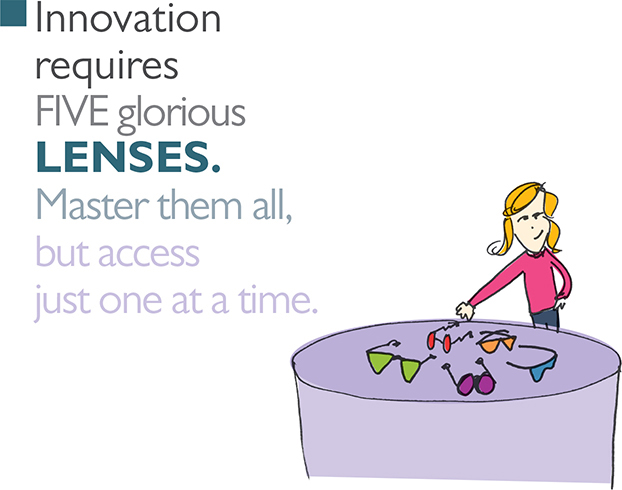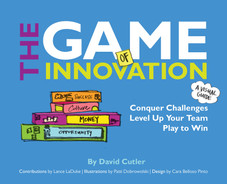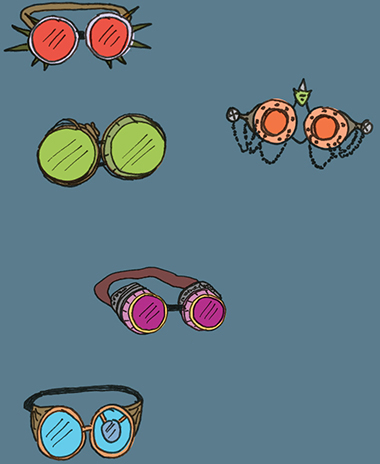
CHAPTER 5
IMPROVE YOUR VISION
IMPROVE YOUR VISION with the five lenses of innovation. GAMEs and teams should align thinking modes during each step of the process.
What perspective?
IMPROVE YOUR VISION
Suppose your team brainstorms.
Suggestions start to fly. Momentum builds—until someone disparages, “That’s a terrible idea.” Another puzzler offers a history lesson: “We tried that 10 years ago.”
Make no mistake. Critical feedback is, well, critical. So is historical reflection. Just not during ideation.
Even if comments are 100 percent accurate, now simply isn’t the time. Beyond stealing valuable seconds, it poisons the air. In the future, explorers may become hesitant to contribute. Why stick out my neck, just to be shot down?
The human mind is capable of a great many things. It can imagine, recall, interpret, critique, praise, ponder, and commit. Incoming data is channeled to your head (analysis) or heart (emotion). A logical left-brain is married to a creative right-brain counterpart.
Innovation champions skillfully tap into all these aptitudes. However, they avoid the urge to access competing perspectives simultaneously.
Cognitive multitasking is horribly inefficient.
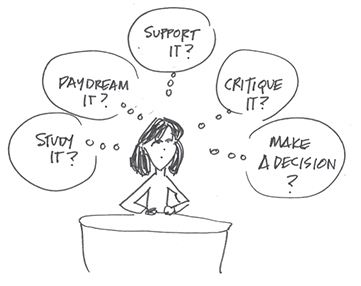
Problem Solving Blindfolded
A Puzzler Company Drama
Part comedy, part drama, part tragedy, the play that follows features five colleagues challenged to solve an important puzzle. Though characters are fictional, countless real-life meetings inspired this work.
Character List


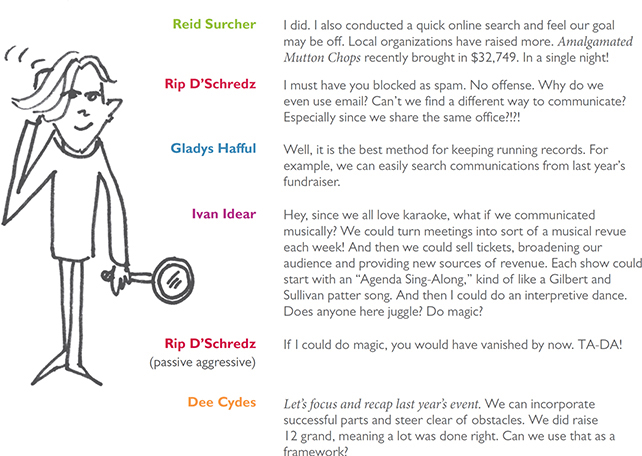
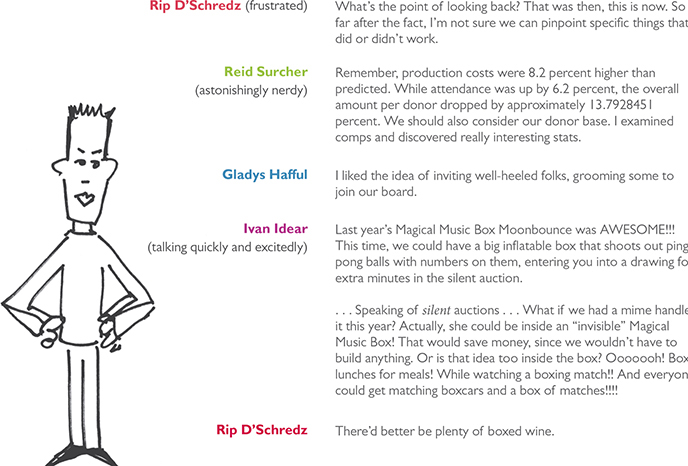
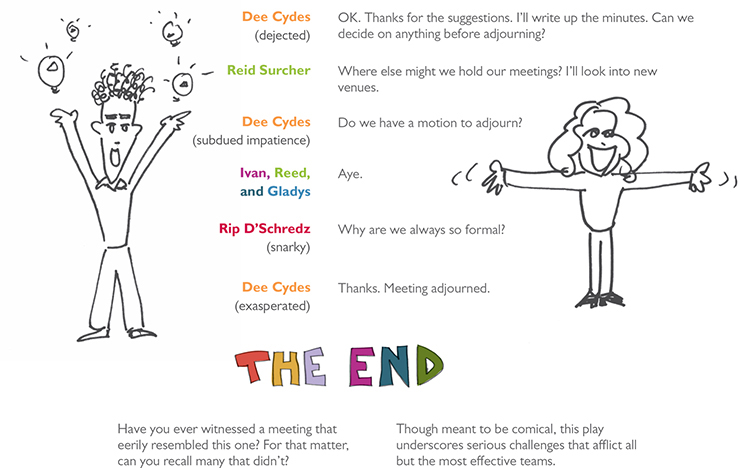
Great Gaming Goggles
Revolutionizing the art of innovation, Great Gaming Goggles (G3) are a breakthrough invention available everywhere imaginations are found. Easy to master, they quickly transform puzzling—when worn faithfully—improving efficiency and effectiveness.
G3 include five different colored lenses.
Furthermore, each color imposes a distinct perspective beginning with the same letter. All are powerful, and all may be necessary for cracking a particular puzzle. But there’s a catch:
Just one lens type at a time.
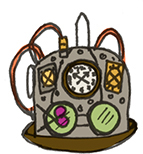
Though widely divergent contributions are encouraged, G3 focus the brain, requiring puzzlers to stay in a single problem-solving lane. Combining two or more causes vision to get blurry.
On teams, G3 are controlled by a facilitator who simultaneously switches every puzzler’s device to the same color. As a result, puzzlers work harmoniously and amplify progress.
Appropriate lenses should be baked into the GAME, supported with carefully worded prompts.
Though G3 are metaphorical, it can be helpful to reinforce implications with physical items. When training communities to use this tool, The Puzzler Company often incorporates cutout paper colored frames, on sticks.
“Multitasking divides your attention and leads to confusion and weakened focus.”
—Deepak Chopra, Indian American writer and alternative medicine advocate
 The 5 Lenses of Innovation
The 5 Lenses of Innovation
Techniques for maximizing the power of each lens are described in a corresponding chapter.
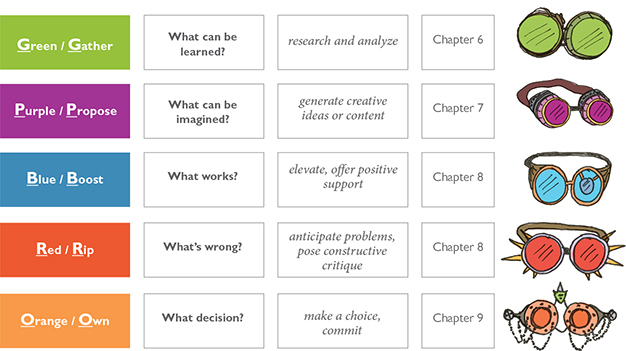
 Character Breakdown
Character Breakdown
Characters from Problem Solving Blindfolded may be hardworking and well-intentioned. But they need help with puzzling. Each colleague is limited to a single perspective, causing friction at every turn.
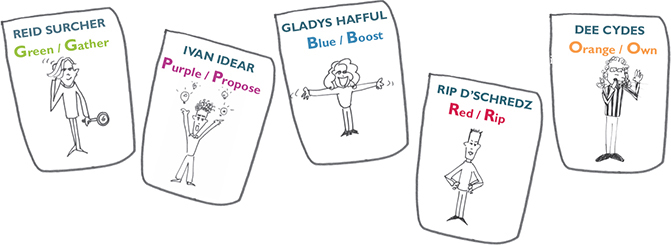
Like these puzzlers, most people are intuitively more comfortable with certain approaches over others.
Luckily, everyone can learn to use all the lenses.
A little training—and clear GAME design—goes a long way.
Playbill Analysis 
Great leaders ask questions that clearly signal the requested perspective. How did Dee do?
Before we get going, are there any opening remarks?
This inquiry implies no lens, inviting anybody to offer anything. Reid barges in with irrelevant nonsense about room dimensions.
In attempt #2, Dee better articulates the challenge:
We’re here to discuss this year’s Magical Music Box fundraiser. Let’s settle on a clear plan that raises $15,000.
But then she blows it by asking a yes/no question rather than anything productive.
Did you get the agenda?
Effort #3 is better yet.
Why don’t we recap last year’s event? . . . Let’s build on that.
Examining the past is a great tactic. But which lens is requested? A factual analysis (GREEN) or critical evaluation (BLUE/RED)? Ambiguity leaves the floodgates wide open. In many cases, negativity drowns the room, which is exactly the case here. Rip rips:
What’s the point of looking back? That was then, this is now.
Magical Music Box needs Great Gaming Goggles, and fast!
Fortunately, this tool can be quickly mastered with minimal training.

 Coloring Book
Coloring Book
Frustrated with her ineffectual, unproductive team meetings, Dee Cydes knows one thing: It’s time to seek help. After her enthusiastic friend Moe Tivayshun raves about his experiences with a tool called Great Gaming Goggles, she decides to give it a shot.
When planning her next meeting, Dee maps out two contrasting short GAMEs, limiting each step to a single lens. First, she considers a 60-minute agenda.
 CHALLENGE A: Design a fundraising event for a new audience.
CHALLENGE A: Design a fundraising event for a new audience.
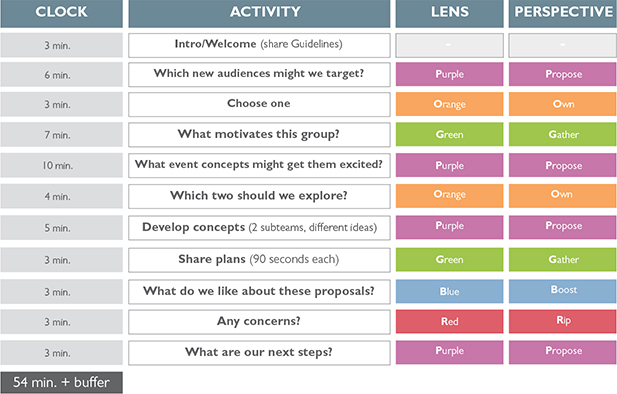
 CHALLENGE B: How might we improve upon last year’s event?
CHALLENGE B: How might we improve upon last year’s event?
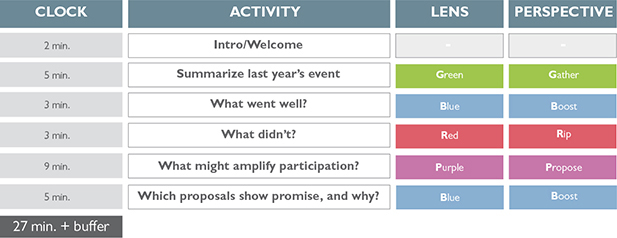
These examples offer several important lessons:
• It is common to require the same lens multiple times. (Challenge A incorporates four PURPLEs.)
• A GAME mustn’t incorporate all five lenses. (Challenge B omits ORANGE).
• Always leave a buffer. (Challenge A schedules 54/60 minutes. Challenge B assigns 27/30.)
Most people are inherently drawn to one or two lenses. They were simply born a dreamer (PURPLE), analyst (GREEN), or critic (RED). Natural inclinations benefit you and your community, so proudly lean into strengths.
But also commit to improving aptitude with the other perspectives.
To build balanced and effective teams, carefully recruit a combination of orientations.
